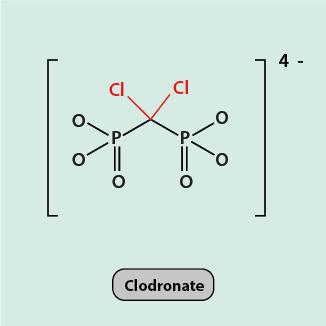Clodronate
Clodronate belongs to a category of medications known as antiresorptives. More specifically, clodronate is one of a number of different bisphosphonates within this category of medications (Figure 1). Bisphosphonates are medications used for the treatment of osteoporosis (brittle bones) and bone metastases.

The most prominent aspect of antiresorptive medications in an oral and maxillofacial surgery context are their adverse effects. Antiresorptive medications are the most common cause of necrosis of the jaw bones, known as MRONJ (medication-related osteonecrosis of the jaws).
Antiresorptive medications are normally not prescribed in maxillofacial surgery. However, here we mention clodronate separately as an occasional exception. Clodronate is one of three components of a controversial medication scheme, advertised for the treatment of osteoradionecrosis, a severe long-term (life-long) risk following radiotherapy in the head & neck region. The cocktail of medicinal drugs, also known as ‘triple therapy’ or PENTOCLO, consists of pentoxifylline, tocopherol and clodronate. The evidence base about the working principles of this medication scheme and the related hypotheses about the pathology of osteoradionecrosis are conflicted. In addition, the original ‘triple therapy’ has sometimes become ‘penta-therapy’ with the rather random addition of ciprofloxacin (an antibacterial agent) and prednisolone (a steroid) twice a week. It strikes one as counterintuitive to prescribe a drug for the treatment of osteoradionecrosis, when bisphosphonates themselves are known to carry an enhanced and long-term risk for causing osteonecrosis of the jaws. Accordingly, there has been a reluctance to include clodronate in medication schemes for treating osteoradionecrosis of the jaws. It is also worth mentioning that in the UK the National Institute for Health and Care Excellence (NICE) only recommends PENTOCLO / ‘triple therapy’ for the treatment of osteoradonecrosis of the jaws in the framework of clinical trials but not otherwise.
The combination of drugs in ‘triple therapy’ was originally proposed for the treatment of fibrosis (scar formation) and soft-tissue necrosis after radiotherapy treatment of breast cancer. So far, it has not been convincingly explained how and why exactly the same considerations and treatment should apply for the treatment of osteoradionecrosis of the jaws.